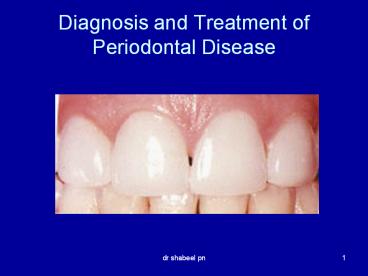Diagnosis and Treatment of Periodontal Disease - PowerPoint PPT Presentation
Title:
Diagnosis and Treatment of Periodontal Disease
Description:
Diagnosis and Treatment of Periodontal Disease STAGES OF GINGIVITIS AND PERIODONTAL DISEASE Did you know? Gum disease is a common dental problem that may result in ... – PowerPoint PPT presentation
Number of Views:4609
Avg rating:3.0/5.0
Title: Diagnosis and Treatment of Periodontal Disease
1
Diagnosis and Treatment of Periodontal Disease
2
STAGES OF GINGIVITIS AND PERIODONTAL DISEASE
3
Did you know? Gum disease is a common dental
problem that may result in tooth loss. Gingivitis
and Periodontitis are the most common types of
adult gum disease.
4
HEALTHY GUMS
5
Healthy teeth and gums are maintained by daily
plaque removal from all surfaces of the tooth
(through tooth brushing and interdental cleaning)
6
Healthy gums are characterized by the following
features
- pink or coral pink color, (normal variations in
color depend on race and complexion) - firm, resilient tissues
- 'orange-peel' texture (known as stippling)
- shape that follows the contour of the teeth and
forms a scalloped edge - no areas of redness, swelling or inflammation
- no bleeding during daily plaque removal
- no discomfort
7
(No Transcript)
8
WHAT IS GINGIVITIS ?
9
WHAT IS GINGIVITIS ?
- Gingivitis is inflammation of the gum tissue.
- The gums are irritated and swollen due to a
plaque or calculus (tartar) buildup along the gum
line. - The gums may be sore, bleed easily and appear
puffy, soft and swollen.
10
WHAT IS GINGIVITIS ?
- No bone structure is lost around the teeth at
this stage of gum disease. - Blood on the toothbrush or dental floss is one
of the earliest and most common signs of
gingivitis. - Your gums should never bleed while brushing or
flossing. - The good news about gingivitis is that it is
preventable and reversible through good brushing
and flossing techniques (or other interdental
tooth cleansing). - On the other hand, if oral hygiene habits are
poor, gingivitis may progress to periodontitis.
11
Gingivitis Notice the gums are red and swollen
12
WHAT IS PERIODONTAL DISEASE?
- Periodontal disease is destruction of bone and
the structures supporting the teeth.
Unfortunately periodontitis is irreversible, but
you can stop its progression through good oral
hygiene and visiting your dental professional.
13
Eight Warning Signs of Periodontal Disease
- gums that bleed when you brush or floss your
teeth - gums that are red, swollen or tender
- gums that have pulled away from teeth
- infection including purulence (pus) between the
teeth and gums when the gums are pressed
- permanent teeth that are loose or separating
- any changes in the way your teeth fit together
when you bite - any changes in the fit of your partial denture
- bad breath
- itchy sensation
14
EARLY AND MODERATE PERIODONTITIS
15
EARLY AND MODERATE PERIODONTITIS
- Periodontitis occurs when the inflammation of the
gums progresses into the deeper underlying
structures and bone. - In the most common form of periodontitis, plaque
(and sometimes calculus) is found below the gum
line. - The gums may feel irritated, appear bright red,
and bleed easily.
16
EARLY AND MODERATE PERIODONTITIS
- The ligaments holding the tooth in its socket
break down and the gums pull away from the teeth,
resulting in a periodontal pocket or space
between the tooth and gum. - The periodontal pocket deepens and fills with
more bacteria. Supportive ligaments and bone
start to show damage.
17
EARLY AND MODERATE PERIODONTITIS
18
(No Transcript)
19
ADVANCED PERIODONTITIS
20
ADVANCED PERIODONTITIS
- When periodontitis progresses to the advanced
stage, the gums severely recede (pull away from
the tooth ) pockets deepen and may be filled
with pus.
21
Advanced Periodontitis
- There may be swelling around the root and you may
experience sensitivity to hot or cold or feel
pain when brushing your teeth. This is due to the
severely receding gums exposing the root surface.
22
Advanced Periodontitis
- As bone loss increases, your teeth may lose so
much support that they need to be removed to
preserve the overall health of your mouth.
23
Advanced Periodontal Disease
24
(No Transcript)
25
Treatment of Periodontal Disease
- Prevention
- Detection
- Assessment
- Scaling, debridement, root surface planing
- Periodontal surgery
- Bone grafting
26
Prevention
- Regular homecare
- Brush
- Floss
- Rinse
- Aids to oral hygiene
- Regular dental visits
- Dietary consideration
27
(No Transcript)
28
(No Transcript)
29
Detection
- Signs and Symptoms
- Bleeding, inflamed gums
- Halitosis
- Discoloration/Stain
- Long in the tooth
- Mobility
- Radiographic findings
- Periodontal probing depths
30
Detection
31
(No Transcript)
32
(No Transcript)
33
(No Transcript)
34
(No Transcript)
35
Assessment
- Radiographs
- Periodontal Charting
- Diagnosis
- I
- II
- III
- IV
- Prognosis
36
Scaling, debridement, root surface planing
37
(No Transcript)
38
Periodontal surgery
39
Deep pocket with calculus
40
Flap Reflected to Visualize Calculus
41
Gum sutured back to normal height, leaving a
deepened space
42
Gum sutured down to bone to reduce residual space
43
Bone grafting
44
Flap reflected to allowbone implant
45
Flap resutured overbone implant
46
Flap reflected toinsert membrane
47
Flap resuturedover membrane
48
Mucogingival Surgery
49
Oral Irrigation
50
Pharmacological Intervention
- Topical Antibiotics
- Tetracycline
- Doxycycline
- Minocycline
51
Pharmacological Intervention
- Periochip (cholorhexidine, and bacteriocidal
drug) - Atridox (doxycycline antibiotic, a form of
tetracycline) - Arestin (minocycline antibiotic, a form of
tetracycline)
52
(No Transcript)
53
Post Treatment Care
- Regular periodontal maintainance
- 3 month recare
- Monitor probing depths
- Follow up radiographs
- Empahasis on Homecare































